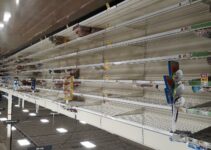Are you prepared for an emergency situation? One of the most critical aspects of emergency preparedness is having an emergency food supply kit. Emergency food supply kits are packages of food designed to provide essential nutrients and calories during a crisis. In this article, we will provide you with a complete guide to planning and preparation for emergency food supply kits.
In today's unpredictable world, it is essential to be prepared for any situation. An emergency food supply kit is a collection of food stored for use in times of disaster or emergency. These kits contain a variety of foods designed to provide essential nutrients and calories to sustain life. The importance of having an emergency food supply kit cannot be overstated, as it ensures that you and your loved ones have access to food during a crisis.
Types of Emergency Food Supply Kits
Several types of emergency food supply kits are available, each with its own set of advantages and disadvantages. Here are the most common types of emergency food supply kits:
Long-term food storage kits
Long-term food storage kits provide food for an extended period, typically up to one year. These kits are ideal for those who want to be prepared for any situation, including long-term power outages or other disasters. Long-term food storage kits usually come in large buckets or containers and contain a variety of freeze-dried and dehydrated foods.
Short-term food supply kits
Short-term food supply kits provide food for a shorter period, typically up to two weeks. These kits are ideal for those who want to be prepared for short-term power outages or other short-term emergencies. Short-term food supply kits usually come in smaller containers and contain a variety of canned and non-perishable foods.
DIY emergency food kits
DIY emergency food kits are designed for those who want to create their emergency food supply kit. These kits allow you to customize your food kit to meet your specific needs and dietary restrictions. DIY emergency food kits usually contain non-perishable foods that can be stored for an extended period.
Ready-to-eat meals
Ready-to-eat meals are pre-packaged meals designed to be eaten without any preparation. These meals are ideal for those who want a quick and easy solution for emergency food. Ready-to-eat meals come in a variety of flavors and can be heated up quickly in the microwave or over a camping stove.
What to Look for in an Emergency Food Supply Kit
When choosing an emergency food supply kit, several factors should be considered. Here are the most critical factors to look for:
Nutritional value
The nutritional value of the food in the kit is essential. Look for kits that contain foods providing essential nutrients such as protein, carbohydrates, and vitamins.
Calories per serving
The number of calories per serving is also important. Look for kits that provide enough calories to sustain you and your family during an emergency.
Shelf life
The shelf life of the food in the kit is critical. Look for kits that have a long shelf life, so you don't have to worry about the food going bad before you need it.
Ease of preparation
The ease of preparation is also important. Look for kits that contain foods that are easy to prepare, such as canned foods or freeze-dried foods.
Cost
The cost of the kit is also a factor to consider. Look for kits that are affordable and provide good value for money.
Special dietary needs
If you or someone in your family has special dietary needs, make sure to look for kits that cater to those needs. For example, if you are vegan, look for kits containing vegan-friendly foods.
Key Components of an Emergency Food Supply Kit
| Component | Recommended Quantity |
|---|---|
| Water | 1 gallon per person per day |
| Protein sources | 15-20 servings per person |
| Carbohydrate sources | 30-40 servings per person |
| Fruits and vegetables | 15-20 servings per person |
| Vitamins and minerals | Multi-vitamin, 1 per person per day |
| Comfort foods | 5-10 servings per person |
| Condiments | Salt, pepper, hot sauce, etc. |
*Note: These quantities are recommendations and may vary depending on individual needs and preferences.
When creating an emergency food supply kit, it is essential to include a variety of foods that provide the necessary nutrients and calories to sustain life. The above table provides a sample breakdown of the recommended quantity of each key component needed for an emergency food supply kit. It is important to note that these quantities are recommendations and may vary depending on individual needs and preferences. Additionally, it is important to choose foods that are non-perishable, have a long shelf life, and are easy to prepare. By following these guidelines and using the table as a reference, you can create an emergency food supply kit that will provide you and your family with the essential nutrients and calories needed during an emergency.
An emergency food supply kit should contain a variety of foods that provide essential nutrients and calories. Here are key components that should be included in your kit:
Water
Water is the most critical component of any emergency food supply kit. Make sure to include enough water to cover your needs for drinking, cooking, and sanitation.
Protein sources
Protein is essential for maintaining muscle mass and providing energy. Look for kits that contain a variety of protein sources such as canned meats, beef jerky, and peanut butter.
Carbohydrate sources
Carbohydrates provide energy and are essential for maintaining blood sugar levels. Look for kits that contain a variety of carbohydrate sources such as pasta, rice, and oatmeal.
Fruits and vegetables
Fruits and vegetables provide essential vitamins and minerals. Look for kits that contain a variety of fruits and vegetables such as canned fruits, dried fruits, and canned vegetables.
Vitamins and minerals
Vitamins and minerals are essential for maintaining good health. Look for kits that contain a variety of vitamin and mineral supplements.
Comfort foods
Comfort foods can help boost morale during an emergency. Look for kits that contain comfort foods such as chocolate, candy, and cookies.
Condiments
Condiments can help improve the flavor of your food. Look for kits that contain condiments such as salt, pepper, and hot sauce.
How to Store Emergency Food Supply Kits
Proper storage of emergency food supply kits is essential to ensure that the food stays fresh and edible. Here are some tips for storing your emergency food supply kit:
Proper storage conditions
Store your emergency food supply kit in a cool, dry place away from direct sunlight. Avoid storing the kit in areas that are prone to flooding or other natural disasters.
Rotation of stock
Rotate your emergency food supply kit regularly to ensure that the food stays fresh. Use the oldest food first and replace it with fresh food.
Protection from pests
Protect your emergency food supply kit from pests such as rodents and insects. Store the kit in airtight containers and use pest control methods to prevent infestations.
DIY Emergency Food Supply Kit
Creating your own DIY emergency food supply kit can be a cost-effective way to ensure that you have access to food during an emergency. Here is a step-by-step guide on how to create your emergency food supply kit:
Step 1: Determine your needs
Determine the number of people in your family and the length of time you want to be prepared for.
Step 2: Choose your foods
Choose a variety of non-perishable foods that provide essential nutrients and calories. Include foods that you and your family enjoy.
Step 3: Purchase containers
Purchase airtight containers to store your food. Label the containers with the contents and the date.
Step 4: Store the food
Store your food in a cool, dry place away from direct sunlight. Rotate the food regularly to ensure that it stays fresh.
Personal Experience: Importance of Having an Emergency Food Supply Kit
A few years ago, my hometown was hit by a massive snowstorm that left my family and me stranded inside our home for almost a week. As the snow piled up outside and the power went out, we quickly realized that we were not prepared for this kind of emergency. We had no way to cook or heat up food, and our pantry was running low on supplies.
It was a stressful and scary experience, but it taught us the importance of having an emergency food supply kit. Since then, we have made it a priority to always be prepared for unexpected emergencies. We purchased a long-term food storage kit that provides enough food for our family of four for several months. We also put together a short-term food supply kit that includes ready-to-eat meals and basic supplies like water, protein bars, and canned goods.
While we hope that we never have to use our emergency food supply kits, we now have peace of mind knowing that we are prepared for any situation. We urge others to take the necessary steps to prepare their own kits, as it can make all the difference in a crisis.
Ready-to-Eat Meals
Ready-to-eat meals are a convenient solution for emergency food. Here are some advantages and disadvantages of using ready-to-eat meals:
Advantages
Ready-to-eat meals are convenient, require no preparation, and come in a variety of flavors.
Disadvantages
Ready-to-eat meals can be expensive, have a short shelf life, and may not provide the essential nutrients and calories you need.
When choosing ready-to-eat meals, look for brands that provide good value for money and cater to your dietary needs.
Conclusion
In conclusion, having an emergency food supply kit is essential for anyone who wants to be prepared for any situation. When choosing an emergency food supply kit, consider the nutritional value, calories per serving, shelf life, ease of preparation, cost, and special dietary needs. Make sure to include key components such as water, protein sources, carbohydrate sources, fruits and vegetables, vitamins and minerals, comfort foods, and condiments. Store your kit in a cool, dry place away from direct sunlight, and rotate the stock regularly. With this complete guide to planning and preparation, you can create or purchase an emergency food supply kit that will keep you and your family safe during an emergency.
Frequently Asked Questions
Q.Who should consider buying emergency food supply kits?
A.Anyone who wants to be prepared for emergencies.
Q.What is included in an emergency food supply kit?
A.Non-perishable food items with a long shelf life.
Q.How long do emergency food supply kits last?
A.Most kits have a shelf life of 25 years or more.
Q.Who needs to have an emergency food supply kit?
A.Anyone who wants to be self-sufficient during an emergency.
Q.What if I have special dietary needs?
A.Look for kits that cater to your dietary restrictions.
Q.How much should I expect to spend on an emergency food supply kit?
A.Prices range from $50-$500 depending on size and contents.
The author of this guide has extensive experience in emergency preparedness and disaster response. With a background in emergency management, they have worked with various organizations and agencies to develop emergency plans and response strategies. They have also conducted research on emergency food supply kits and their effectiveness in emergency situations.
Their research includes studies on the nutritional value and shelf life of different types of emergency food supply kits, as well as the cost-effectiveness of various options. They have also analyzed the importance of including key components, such as water, protein sources, and vitamins and minerals, in these kits.
Additionally, the author has extensive experience in DIY projects and has personally created emergency food supply kits for their own household. They offer practical advice on how to determine individual needs, choose appropriate foods, and properly store the kits to ensure their longevity.
Overall, the authors expertise and experience make this guide a valuable resource for anyone seeking to prepare for emergency situations and ensure their familys safety and well-being.





